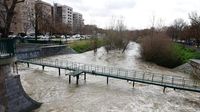As Spain faces severe weather conditions, the northern regions, especially Talavera de la Reina, are grappling with serious flooding issues after the collapse of crucial infrastructure. The Roman bridge, known as Puente Viejo, suffered damage as the water flow reached alarming levels, exceeding 1,000 cubic meters per second. On March 22, municipal authorities initiated a second security perimeter around the bridge, urging residents to stay clear for safety reasons.
The mayor of Talavera de la Reina, José Julián Gregorio, expressed profound sadness on social media: “This night is a terrible day for the history of Talavera. Our old or 'Roman' bridge has just collapsed partially. A terrible water flow for the city. We are thankful that it was closed to citizen passage. Today my heart as mayor suffers for this heritage loss.”
The mayor’s sentiments were echoed by Politician Paco Núñez, who extended support to the community during this distressing time. He stated, “Much encouragement to Talavera de Reina. Undoubtedly, this is a painful loss for the city and its history. Concern is at its highest right now. I maintain continuous contact with the mayor to convey all our support and collaboration for him and his neighbors.”
In addition to the bridge collapse, the situation in Talavera has also drawn attention to the rising levels of the Tagus River. The river surpassed 1,000 cubic meters per second, categorized as a "historical rise," necessitating immediate emergency preparations to safeguard local inhabitants. “We need to be extremely cautious and avoid floodable areas,” Gregorio has warned.
Meanwhile, the Spanish Meteorological Agency (AEMET) has issued an orange alert for northern coastal communities, expecting heavy rains and strong winds, stressing the importance of vigilance in the region. The expected heavy rainfall is forecasted to worsen conditions already critical in several municipalities and could lead to further infrastructure deterioration.
Emergency services in San Fernando de Henares, which has already reported numerous flood incidents, including the flooding of the Municipal Sports Complex Justo Gómez Salto, are on high alert. The river Jarama reached historic flood levels, causing additional complications and infrastructure damage, although thankfully no personal injuries were recorded.
Amid these challenges, authorities have communicated the necessity for precautions. Efforts are ongoing to provide shelter for those displaced by flooding circumstances. Community sports venues have been designated to temporarily accommodate evacuees should the need arise, and local councils are collaborating with emergency services to ensure public safety.
On March 23, temperatures in the northern coastal regions of Spain are forecasted to drop significantly, with forecasts indicating snow at altitudes between 800 and 1,200 meters, particularly affecting mountain ranges in central Spain. The winter storm Martinho, which has caused havoc across regions, continues to warrant provincial alerts as conditions evolve.
Meanwhile, in Hinojos, Huelva, local farmers began to evacuate approximately 600 cattle from Galician Marshlands to ensure their safety, following the risk of flooding areas that could jeopardize their livestock. Consequently, around 95% of the evacuation was reported to be complete by early afternoon on March 22.
The calamity inflicted by Martinho has inspired proactive responses from several governmental and non-governmental agencies. Evacuation measures, continuous monitoring of rainfall and river conditions, and strategies for community safety and health remain in high priority as officials work diligently to mitigate risks.
If every forecast and report rings true, the impending weather challenges could continue to affect vital infrastructures across Spain throughout the weekend and beyond, reinforcing the importance of community diligence and coordination among emergency response teams.
As the rains are forecasted to subside, affected regions may start addressing the physical ramifications of flooding conditions. Restoration and extensive cleanup efforts are anticipated to follow, with the overarching goal of restoring normalcy for the communities impacted.
In retrospect, the current weather-related phenomena highlight the resilience and dedication of citizens and their leaders working tirelessly in the face of adversity.





